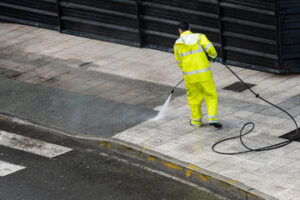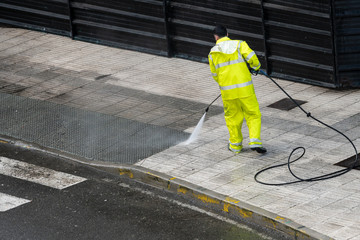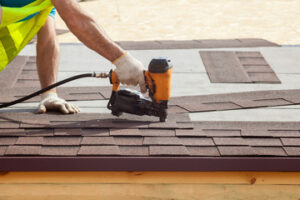Pressure Washing Austin is an effective cleaning method for dirt, mildew, and mold on surfaces. It is also an effective way to clean hard-to-reach areas of the home and property.
Before starting, apply a detergent to the surface you want to clean and attach a nozzle that fits your specific pressure washer. Test a small area of the surface first to ensure the right amount of water pressure is used without damaging the surface.
Pressure washing is a powerful cleaning method that blasts away dirt, grime, and mildew build-ups from surfaces and objects. It’s suitable for a variety of outdoor surfaces, including driveways, patios, sidewalks, roofs, gutters, and siding. It’s also effective at removing stubborn stains from hard-to-reach areas.
It’s important to use the proper pressure settings and technique for each surface type to avoid damage. Incorrectly used, it can cause etching on glass, pitting of wood, and cracking of concrete. Professionals are trained in the correct techniques and tools for each surface and can adjust pressure levels as needed to clean effectively without causing harm.
Detergents are often added to the water spray to improve its cleaning effectiveness. By lowering surface tension and emulsifying oils, detergents can break down more stubborn contaminants that are otherwise difficult to remove. This makes pressure washing a more efficient and effective way to tackle tough stains than simply using water alone.
Adding chemicals to the water spray can also help to reduce odors and prevent corrosion. It’s important to follow the manufacturer’s instructions for the proper dilution ratio. It’s also important to wear protective equipment, including gloves, goggles, and long pants and sleeves. Lastly, it’s crucial to keep the spray away from pets and children, as the high-pressure water can be dangerous.
The best time to pressure wash depends on the season and what you’re trying to clean. For example, it’s best to pressure wash exterior surfaces in the spring and fall before they start to dry out. It’s also best to avoid pressure washing during freezing temperatures, as the freeze-thaw cycle can damage some surfaces.
Some surfaces are better suited for soft washing than pressure washing. This is because they are more delicate and can be damaged by the high-pressure water. Our technicians will assess each situation on-site to determine which method is best for the job. For the most safe and effective results, we recommend combining pressure washing with a softer approach like soft washing. This combines the power of high-water volume with gentle soaps and detergents to provide a more thorough cleaning while reducing the risk of damage.
Reduces Stains
Pressure washing is extremely effective for eliminating stubborn stains and dislodging accumulated dirt, mud, mold, mildew, or other contaminants. Combined with appropriate cleaning detergents, the force of the water stream penetrates deeply into porous surfaces like concrete and brick to lift embedded stains. The nozzle settings on modern pressure washers are highly customizable, allowing users to control PSI (Pounds Per Square Inch) and GPM (Gallons Per Minute), maximizing cleaning results without surface damage.
It is important to use caution when operating a power washer and only apply the water pressure at a safe distance from the surface. Surfaces may require pre-treatment with a degreaser or other specialized cleaner to maximize removal of oil, grease, and other tough stains. Always adhere to manufacturer instructions for diluting and applying the cleaning solutions, and test a small area before full-surface application.
The high-pressure water stream also dislodges and kills mold, mildew, moss, and other plant growth, helping prevent the build-up of these toxins on exterior surfaces. Cleaning regularly with a pressure washer, particularly after rain, can eliminate existing spores and help prevent future growth.
Before beginning a pressure washing project, it is essential to set up a safety perimeter and remove or secure any objects that could be damaged by the high-pressure water. It is also helpful to protect nearby plants by covering them with protective tarps or plastic sheets. Taking steps to prevent accidental plant loss can save homeowners from the time-consuming and expensive task of replacing them later on.
It’s also a good idea to choose a day when the sun is out so that surfaces can dry quickly. Working top to bottom on vertical surfaces, and in overlapping sections on flat surfaces will also speed up the drying process, making for an efficient cleaning job. Finally, it’s a good idea to use an extension cord and a garden hose to supply water instead of connecting directly to the power washer. This will reduce the risk of shocks and electrical hazards.
Using a professional power washing service is highly recommended for homeowners who are unfamiliar with the proper equipment and techniques. Experienced professionals can optimize the PSI, water rotation, and cleaning products for each surface, ensuring quality results. In addition, professional services can save valuable time and effort by completing the project quickly and efficiently.
Reduces Mold and Mildew
Incorporating pressure washing into a preventative maintenance plan protects surfaces from damage and helps them last longer. Dirt, mildew, mold, algae, and other growths can break down exterior surfaces like concrete or masonry over time. Pressure washing eliminates them and keeps the building’s structure in better condition, lowering maintenance costs over time.
In addition to improving aesthetics, regularly cleaning a commercial building increases the safety and health of its occupants. Mold, mildew, and other growths can lead to breathing problems and other health issues. Pressure washing removes them and improves air quality, making it a crucial part of preventative apartment building maintenance.
A clean building enhances its curb appeal and attracts more customers, increasing the property value. It also reduces the risk of slips and falls on sidewalks, driveways, and parking lots. Pressure washing is an inexpensive service that reduces the need for expensive repairs and surface replacements over time.
If you are considering pressure washing your home or business, it’s important to choose a professional with the right equipment and knowledge. They will know how much pressure to apply and what setting to use on each surface for the best results. They will also have the proper safety gear to ensure that you and your family or employees are safe.
Whether you have vinyl siding, aluminum, or another material, a professional can help determine the right level of pressure for each surface. Using too much pressure can damage the surface and cause cracks, while too little pressure won’t fully clean the area.
A general-purpose detergent mixed with a pressure washer can be used to remove many common stains on wood, vinyl siding, shingles, and concrete. More difficult stains may require pre-treatment with a chemical product and then pressure washing. For example, a high-pressure setting is often used to remove paint from brick walls, although a lower-pressure setting may be enough for most other surfaces.
It is recommended that buildings are pressure washed three to four times a year for optimal results. Locations with high traffic or harsh weather conditions may require more frequent washing to keep surfaces looking their best.
Prevents Damage
Pressure washing removes dirt, mold, mildew and moss, which can damage surfaces over time. This process can help prevent surface erosion, as well as protect against potential structural damage to your home or business.
In addition, regular cleanings can save money on expensive repairs and maintenance work down the line. This is because dirty surfaces can hide cracks and chips that can lead to major problems later on. When these issues are addressed immediately, they can be treated and repaired before they get worse.
Aside from the aesthetic benefits, a clean exterior can also boost property value. Potential buyers are more likely to pay top dollar for a home or business that is well-maintained and has been regularly maintained by the owner. Pressure washing is an inexpensive way to improve the appearance of your home or business, and it can even act as a primer before repainting or staining.
Dirt and debris build-up on surfaces creates the perfect environment for bacteria and vermin to thrive. These organisms can spread rapidly, causing structural damage to your building and posing health risks for inhabitants. Pressure washing removes these threats and creates an environment that is less hospitable to pests, protecting your family or employees’ safety.
Algae is another common issue that can cause severe surface degradation if left untreated. These microorganisms can cause discoloration, corrode metal surfaces and weaken the integrity of various materials. Effective algae removal through pressure washing preserves the lifespan of your building’s surfaces and keeps them looking their best.
When performed by a professional, pressure washing is safe and effective for most surfaces. Professionals are familiar with the correct nozzle settings and pressure levels to use for each surface type, and they understand how to properly dilute chemicals to ensure they are safe for the intended material. Inexperienced homeowners or contractors can accidentally strip paint, shatter windows and gouge soft stone when using a high-pressure washer without proper training or knowledge.
Pressure washing is an essential part of keeping your home or business healthy and appealing. Regular cleanings can help you save money on repairs and maintenance work, and they can also prevent costly structural damage by reducing the risk of mold and mildew growth and preventing surface erosion. In addition, cleaning your surfaces with a pressure washer can reveal issues that you may not be able to spot with a naked eye, including cracks and chipping.







